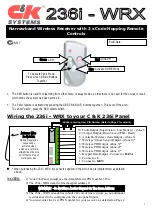
TDFM-136B Operating Instructions
08RE399
2.2.3
Squelch Modes
Squelch mode refers to the method employed to defeat squelch and open the receiver. The
transceiver supports a variety of squelch modes for both analog and digital operation, these are
shown in table 2-2 below.
Table 2-2. Receive and Transmit Squelch Modes
Analog
Digital
Rx
Tx
Rx
Tx
Noise
x
CTCSS Tones
t
Monitor
m
Tal NAC
g
CTCSS Tones
t
DCS Codes
c
NAC Only
n
ID Call
i
DCS Code
c
Inhibit
-
Tal NAC
g
Inhibit
-
Non-Selective Squelch
In analog operating modes (w & n), the Noise squelch is non-selective, that is: if a valid signal of
enough power is present, the squelch will be defeated and the signal received.
Note:
Noise squelch is the only squelch parameter that is global, the value needs only to be set
once on any memory and it will apply to all memories on that channel.
For the P25 digital mode (D), the Monitor mode is non-selective: it a P25 digital signal of enough
power is present, the squelch will be defeated and the signal received. There is no level setting.
Note:
this
does not mean
that encrypted signals will be received and decoded in these modes!
Selective Squelch
The other squelch modes are selective: the transmitting system must be operating in the same
squelch mode as the receiving system, and must provide the correct information within that mode.
Scope
Squelch modes are non-orthogonal, that is, they are not the same across differences in Operating
Mode or for receive and transmit operation.
Parameters in Memory
For each memory created there is a default value for each of the squelch modes: the memory
does have a CTCSS tone, a DCS code, a TalkGroup and a NAC assigned, it is just that these
parameters are not used unless the associated squelch mode is chosen.
Since each squelch parameter exists for each memory, and each has a default value, these default
values, like all user editable channel parameters, can be set. In addition, Squelch use may be
restricted according to: which Squelch Modes may be selected for any Operating Mode, which
Squelch Modes may be edited (ie change value), and – in the case of Tones and Codes – which
values are available to be selected. See the Maintenance Level (L4) for appropriate commands.
Description
For signals that are on frequency and not encrypted, the Squelch Modes work as follows:
In Analog Modes:
Noise Squelch, 'x'
– analog receive only, non-selective. The receiver will open if there is
enough RF energy on frequency. This is the default analog squelch mode.
CTCSS Tone, 't'
– analog receive and transmit, selective. The receiver will open if the signal
received also carries the correct tone. The tones may be the same or different for receive or
transmit on any memory.
DCS Code, 'c'
- analog receive and transmit, selective. The receiver will open if the signal
received also carries the correct code. The codes may be the same or different for receive or
transmit on any memory.
Technisonic Industries Ltd.
11
















































